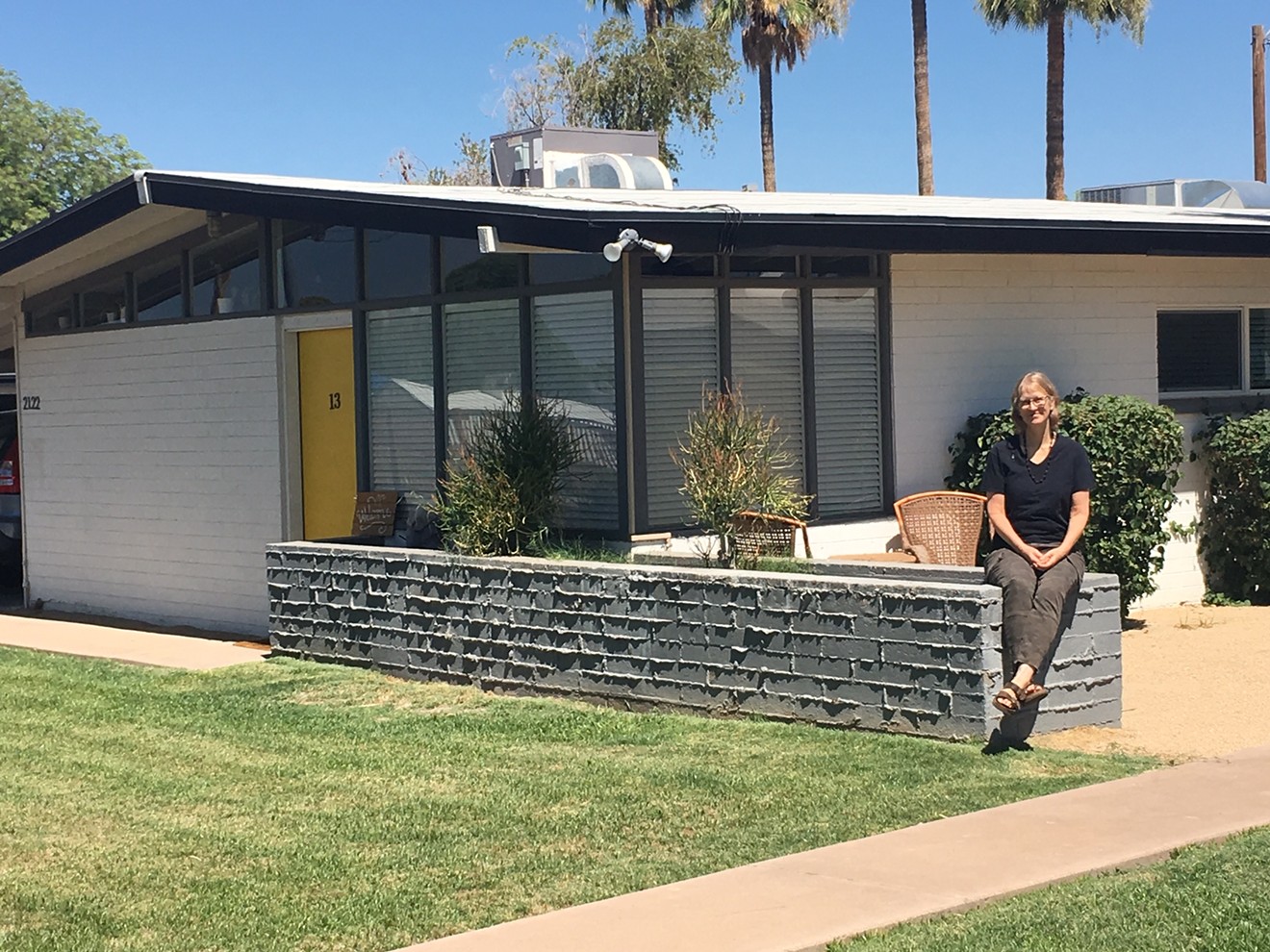
Artist Carolyn Lavender stopped Home Depot from tearing down the Mode apartment complex and other spots in the Loma Linda neighborhood.
Robrt Pela
Carolyn Lavender was out driving with a friend on Saturday morning.
“I’ve lived in this neighborhood since 1987,” she said. “We’ve been gentrified quite a lot, but there’s still the original shabbiness going on. Take a left up here on Fairmount.”
Her friend turned left. “Most of the houses are post-World War II, from the late 1940s and early 1950s. There’s an older house. You can tell by the windows, they’re taller and more vertical.”
Lavender, an artist whose newest work is included in a show at Modified Arts, was explaining how, after months of battle, she and other activists had last month saved her neighborhood from another rotten in-fill project. Home Depot had its eye on a plot of land on East Indian School Road in Phoenix, at the outermost edge of the Loma Linda neighborhood. A developer had been buying up residential and commercial property in Loma Linda, and Home Depot was keen on building a new store there.
“All the people living in these apartments would have had their homes torn down,” she said, pointing to a tidy courtyard complex called Mode at Fairmount. “Up here and around the corner, 10 local businesses would have been displaced.”
Lavender’s friend stopped in front of the complex. “These apartments are so well maintained, and there’s no blight,” Lavender said. “There’s 22 units.”
The apartment buildings were made of gray slump block and had peaked roofs and Ralph Haver-esque
facades framed with triangles of glass. The lawns were green and the doors were freshly painted. Next door to the east was a smaller, similar complex.
“The guy who owns that complex really wanted the sale,” she said, then shook her head. “He was really happy about the money he was going to make, and when I shut down the Home Depot sale, I know I really wrecked his day.”
Lavender got Home Depot to go away by rallying her neighbors, she said, and with correspondence. “My first packet to them was 15 pages with pictures, and it said, ‘Hey, this is what’s being done in your name. People will be displaced. Businesses will have to relocate. You need to be made aware of this. Our fight is huge, and we’re organized.'”
The letters made the difference, Lavender thought. She had collected more than 100 letters of opposition to Home Depot moving into Loma Linda, and sent copies of each letter to City Council member Laura Pastor, to the Village Planning committee, and to the media. Then, Neal Haddad from the Neighborhood Coalition of Greater Phoenix stepped in.
“Neal said, ‘I think you need to mail those to Home Depot, in individual envelopes.’ At that point, I was tapped out financially. I had already spent $500 or $600 on flyers. So, someone else in the community did the mailing. And within two weeks of that, Home Depot pulled out. I owe it to Neil, and all the other people who worked with me on this.”
Lavender said she wasn’t angry at Home Depot. “They weren’t in any of the meetings. They had signed on for the project, but it was the investor and the lawyers who weren’t telling them they’d be right next to an elementary school, they’d evict all these people, they’d tear down these historic apartments, that 10 local businesses would be homeless.”
On the other hand, Lavender thought Home Depot probably didn’t care about any of that.
She pointed across the street. “The woman who lives in that house is so sweet, but she’s sick with cancer, and one of the Home Depot lawyers was terrible to her in a meeting. She said, ‘I can’t be part of this anymore, it’s hurting my health.’”
Lavender and her friend drove around some more. “That empty lot, that’s where the loading dock would have been. They would have torn down this whole two blocks, all the way to Indian School, with the façade facing the street.”
Home Depot tried to build in Loma Linda in 1991, but got run off then, as well. Lavender wasn’t involved in that fight. But she did keep the pawn shop around the corner from selling firearms a few years ago. And she and her husband facilitated a yearlong tree-planting project in 1999. “We planted over 200 trees in our neighborhood, more than half of them ourselves,” she said, then pointed at a leafy desert fern.
She was glad that Loma Linda wasn’t designated an historic neighborhood. The houses there were starter homes, she said, and weren’t special enough for historic designation. “But I like that,” she confided. “We don’t have any historic neighborhood rules here. People can really do anything they want to express themselves. You have to be willing to put up with some bad taste, but you glorify in the idea that your neighbor wouldn’t be allowed to paint his house electric blue in the suburbs.”
Lavender pointed to a brick house covered in plywood. “That one wasn’t boarded up before,” she said. “Shit. Something bad must have happened. The guy who lived there has been sick. I hope he’s okay.”
She pointed out a newly renovated house up the street. “It’s colored stucco, and it’s got the pop-out windows. They’re taking good care of it, and they probably think it looks nice. This is their taste.”
Charcoal grey paint has been the trend lately, Lavender moaned. With red doors. Real estate flippers have changed things in Loma Linda — some of it positive. “But this area was so blighted, I can’t say the gentrification is a bad thing,” Lavender admitted.
She talked a pair of flippers into keeping the façade of the house next door to hers. “They wanted to make the living room bigger by taking the front of the house off. I told them once they did that, the house would be gone forever. The concrete tile, the windows. I’m really proud that I helped change their minds.”
It saddened Lavender that developers had so little interest in local history. She had seen beautiful things torn down and replaced with parking lots. “It wounds me to lose things like that. Old things can transport you into another time and give you a connectivity to history and place.”
Her friend pulled up in front of Lavender’s house. “When you take a big eraser and wipe out history, when you
scrape the earth and start over, you might build something good," Lavender continued.
She took a deep breath and unhitched her seat belt. “But usually, around here, they don’t.”











